



European Cheese Market
The EU cheese market is changing, forcing cheese suppliers to rethink their business models and explore new opportunities for growth. The main drivers behind these changes are falling growth rates in the EU, more pressure on margins because of higher revenues in powder and butter products, and volatility in commodity cheese markets.With the prospect of growth in milk production after the termination of EU milk quotas in 2015, suppliers need to find new ways to deal with the new milk produced. In a mature, competitive and increasingly volatile cheese market, companies have six strategic options for targeting further growth and profitability.
Introduction
Cheese has traditionally been considered the preferred outlet for milk from the European Union (EU) after local fresh-milk requirements have been satisfied. The EU cheese market is the largest in the world, and despite very high per capita consumption levels, growth has remained attractive and stable.
The high production costs of milk in most of the EU rule out a competitive role in supplying the world’s net importing markets with low-priced dairy commodities. Cheese has therefore provided much better export opportunities than any other dairy product, as the willingness to pay for quality European cheese has always been high, and the impact of higher raw-material costs is less problematic. As a consequence, the share of EU milk that is processed into cheese increased from 43 percent to 45 per cent between 2001 and 2010.
However, the cheese market has changed in recent years due to developments in the EU and to global trends. Competition within the EU market is heating up, as the market has become more saturated, the traditionally higher premium for cheese versus other dairy products has eroded, and the commodity segment of the cheese market has become more volatile and unpredictable.
Most of the growth on the global market will be in milk powders and butter oil rather than cheese, as the needs of developing dairy markets are more geared towards these products. As a result, cheese specialists are reconsidering their business models and trying to incorporate new growth areas either in new geographies or in value-adding services.
These developments raise the question of whether cheese should remain the preferred outlet for new milk produced in the EU after 2015, when the termination of the quota system may stimulate growth of milk production in selected regions in western Europe.
Drivers of change
EU growth rates falling
The EU cheese market is still growing, albeit at a declining rate. Average annual growth between 2000 and 2005 was 1.8 per cent and dropped to 1.1 per cent between 2005 and 2010. Annual growth in the period between 2011 and 2015 is forecast to be 0.6 per cent.
Per capita consumption growth accounts for 0.4 per cent of annual growth, with the balance the result of population growth. Growth varies between the different EU member states. Growth rates above two per cent are expected in Ireland, Poland and Hungary. Growth rates between one per cent and two per cent are expected in the UK, Sweden, Spain, Greece and most of the new EU member states. Growth rates in large markets like France and Germany are expected to remain close to zero.
Although demand for cheese as an ingredient in ready-made food products is slightly more sensitive to changes in economic sentiment, growth across the different market segments — industrial, catering and retail — is currently stable.
Over the past decade, the main change in EU cheese demand occurred in the use of cheese by households. Retail purchases, in terms of kilogrammes per household, grew in line with overall market growth, but the share of cheese purchases used for cooking — sauces, toppings and meal ingredients — grew strongly at the expense of more traditional uses, such as cheese on a sandwich or as part of a cheese platter. Despite the overall stability of the EU cheese market, in terms of shifts across categories, the EU market remains a collection of different regional markets with different cheese segmentation profiles (see Figure 1).
The UK comes close to the US consumption profile where catering and industrial ingredients account for a relatively large share of consumption compared to retail purchases. Germany also has a sizeable proportion of ingredient use, as it is the preferred location for a number of large European pizza manufacturers. In countries like Italy, Spain, Poland and France, most cheese is still purchased and consumed through the retail channel.
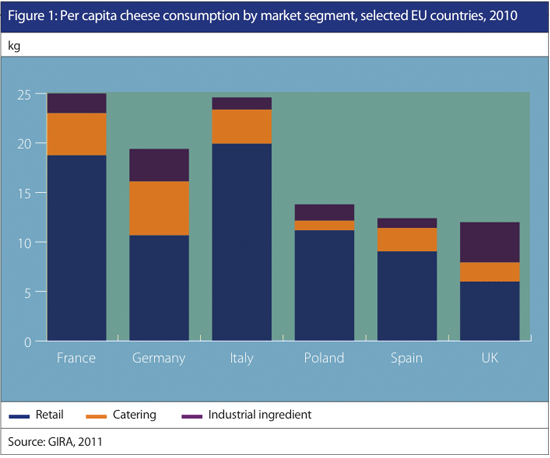
In such a mature market one would expect a strong consolidation trend, but in-market merger and acquisition (M&A) activity in the EU cheese industry has been modest in recent years, and overall brand shares of the leading players have been stable. Private-label shares throughout the EU have remained relatively stable as well, at around 18 per cent on average. The highest private-label shares are found in the cheese categories of Cheddar, Gouda and Emmental. In the specialty cheese categories, private-label shares are very low.
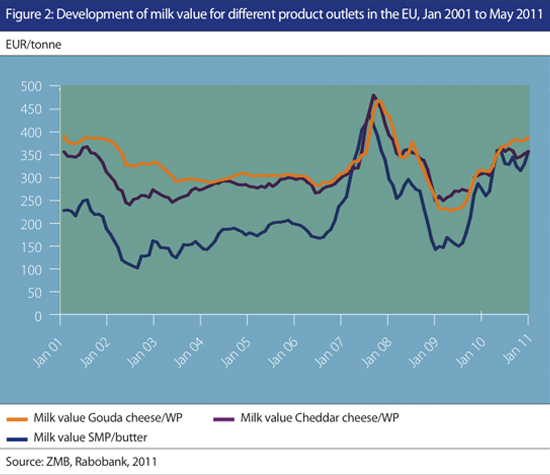
Premium for cheese disappeared
Most EU companies active in cheese have traditionally enjoyed stable and above average returns. Returns for cheese and whey — even in the big commodity cheeses such as Cheddar, Gouda and Emmental — were generally higher than those for skim milk powder (SMP) and butter, meaning that cheese processors could easily pay competitive prices for milk and still generate decent margins.
However, the traditional premium enjoyed by EU cheese makers disappeared after 2007. Demand for milk powders grew faster than for cheese as expanding markets, such as China and Vietnam, rushed to supplement local milk supply with imported products for recombining or ingredient use.
With existing capacity precluding the redirection of sufficient milk to faster-growing product markets, the returns to be made on producing SMP and butter rose faster than those for commodity cheeses such as Gouda or Cheddar, including the whey powder (WP) revenues (see Figure 2). Commodity cheese specialists suddenly found it harder to pay milk prices in line with market trends and still make a profit.
Cheese market used more frequently to offload milk surpluses
After the price support levels of SMP and butter were reduced following the EU dairy market reform of 2002, the period 2002 to 2007 was characterised by multi-product processors exploring other options to offload temporary surpluses of milk. In addition to offering SMP and butter for intervention, they pushed bigger volumes of commodity cheeses into the spot market by undercutting competitors’ prices, and sold Cheddar curd from the UK or Gouda curd from western Europe for making processed cheese or Mozzarella.
Under these market circumstances, manufacturers of Gouda, Cheddar and Emmental — which normally operate in different markets — were competing for the same clients in processed cheese and ingredient applications. As a result, the EU cheese market became more susceptible to general imbalances in the global market triggered by supply or demand issues in products other than cheese. Not only are cheese processors now facing increasing difficulties in generating higher returns compared to SMP and butter, but they are also experiencing higher levels of price volatility at the wholesale level.
In hard and semi-hard cheeses, the maturation process adds further complexity and risk to the price volatility in the market. The maturation process takes from a few weeks to over a year for cheeses like Gouda, Edam and Emmental. This creates a time lag that makes a market-driven approach very difficult in these cheese types. Particularly when the cheese has been produced in times of high raw-material prices, but is not sold until a period in which the entire dairy market has turned around and wholesale prices are low, margins come under pressure and can even become negative (see Figure 3).
EU milk beyond 2015: Which products?
Between 2006 and 2008, a wave of cheese- capacity expansions took place in Mozzarella and other big commodity cheeses, with little or no investments in other commodity products. This wave of investments came to a standstill after 2008, partly because the capacity expansion was not yet fully utilised, partly because of the financial crisis, but also because of the general notion that the world market needed more SMP and butter rather than more cheese. Comparative prices therefore started to reflect these relative shortages within the dairy product portfolio.
With the termination of the quota system on the horizon, the preferred destination of new milk becomes an interesting question. In countries such as Ireland, the Netherlands, Denmark and in selected regions in Germany and France, processors can look forward to milk production increases of between 15 percent and 50 per cent, which could largely be achieved between 2015 and 2020. This implies that processors in these regions — and especially the cooperatives — will have to make decisions on capacity expansion sooner rather than later.
The growing global demand for SMP and butter does not imply that the EU should entirely realign its growth ambitions and forget about cheese. Despite the fact that production costs have risen in the more efficient export regions in the world, most of the milk produced in the EU still cannot compete in the commodity areas of the dairy market. However, higher value-added outlets for milk powders, such as the infant milk formula market, where quality is at least as important as price, are now within reach for new EU milk produced after 2015. At the very least, the options can be distributed more evenly across the dairy portfolio.
Strategies for cheese companies
The drivers of change may challenge companies active in the EU cheese sector to revisit traditional business models and develop new strategies. In a mature, competitive and increasingly volatile cheese market, companies basically have six strategic options for targeting further growth and profitability.
- Consolidating market positions and increasing efficiency in operations and marketing.
- Improving the level of added value in the retail market by developing unique selling points through new traits in the product itself, supported by dedicated marketing and, preferably, brands.
- Improving the added value in the retail market by offering secondary processing and logistics services.
- Developing ingredient solutions for clients that use processed cheese in ready-made food products such as pizzas, sandwiches, cheese snacks and sauces.
- Creating more flexibility in the product portfolio in order to avoid having to ride the highs and lows of the global market.
- Targeting growth in markets outside the EU through dedicated export concepts.
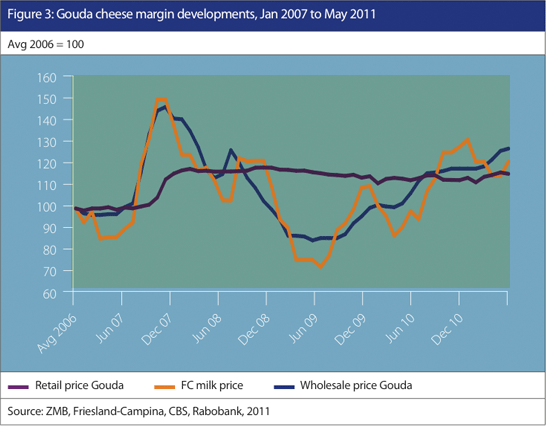
Consolidating market positions
Due to the maturity of the EU cheese market, the strategic focus of many leading players is to consolidate current market positions by acquiring add-ons, and then to rationalise these operations and marketing structures. However, consolidation has been modest, and rationalisation has mainly taken place at the factory level rather than between companies, with the exception of Lactalis, which has consolidated its number-one position in branded cheese by acquiring cheese brands in Italy, the UK, Spain and Central and Eastern European countries. The market shares of the leading EU cheese players are largely stable (see Figure 4). Private-label shares have gradually increased in Western Europe, from 20.5 per cent in 2002 to 22.5 per cent in 2009, while staying very low (around two per cent) in the growing Central and Eastern European cheese markets.
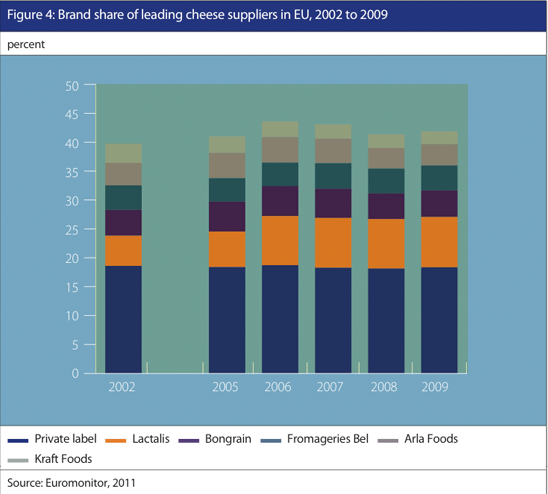
Improving value-add potential in retail market
In the last decade, most of the dominant players in the branded EU retail market have focussed their new product development on line extensions and packaging innovations targeted at convenience. Nonetheless, there have been many examples of successful new product launches in recent years.
Products targeted at satisfying snacking demands, such as cheese snacks children can take to school, have been particularly successful. So have cheeses with a link to the regions where they are produced such as products with Protected Geographic Indications (PGI) or Protected Designations of Origin (PDO). Consumers are willing to pay more for regionally produced specialty cheeses when they combine good quality and taste with a strong marketing story. Specialty cheese stores use these cheeses to distinguish their range from the large retailers. However, retailers also open up shelf space for regional concepts.
These concepts may range from the ‘Buy British’ story developed by Tesco in the UK to the small-scale farmhouse production of Comté by French dairy farmers in the Jura region. Cheeses that have low fat levels without compromising too strongly on flavour were also a success story. The big boom in low- fat cheeses seems to be over, but the high content of saturated fats remains a weakness for conventional cheese.
The ambitions of Danish food regulators to tax cheese in line with other unhealthy consumer products like alcohol and tobacco provides another argument that the high fat levels in cheese make the product vulnerable to these initiatives. There is no reason to expect revolutionary developments in cheese innovation since the EU cheese market already offers a sophisticated and diverse range. As it appears that most options to change the product itself have already been exhausted, most future innovations will target the aspect of convenience by offering flexibility of utilisation in the kitchen or by introducing new formats and packaging to improve portability, thus increasing the number of occasions when cheese can be consumed.
Developing secondary processing and dedicated services for retailers
As the process of cheesemaking — particularly for big commodity cheeses such as Cheddar, Gouda, Edam and Emmental — has become standardised and cost-driven, many companies have developed specialist business models for value creation in the downstream part of the chain. These business models include warehousing and maturation services for retailers and/or primary processors, logistic and packaging services for retail customers and foodservice, and developing private-label concepts and category management roles for retailers.
While these services are sometimes in the hands of primary cheese manufacturers, most often these roles are further developed by companies that started off as traders but adopted value- adding services to escape the low margins in trade. Many manufacturers of the big commodity cheeses have been focussing on scale and cost advantages in recent decades. By doing so, they have lost the flexibility to service individual clients, which has opened up plenty of opportunities for smaller companies. Especially in consolidated retail markets, it pays to set up dedicated cutting and packing lines for single retail clients. The UK and the Netherlands provide many examples of how these dedicated investments represent a strong guarantee for continued business since the mutual dependence is high.
Developing value-adding ingredient solutions for customers in food processing
Cheese used as an ingredient in processed food products was one of the main growth drivers of the EU cheese market in the 1990s. However, many cheese manufacturers have long considered the cheese-ingredient market a secondary market and have failed to recognise the opportunities that were obvious to many ingredient specialists in the general food market. There is great value to be captured in offering tailored solutions to large customers in food processing. This is a different proposition than occasionally shipping big blocks of cheese to ingredient customers during times of oversupply in the cheese market. The growth in this part of the cheese market during the 1990s saw the emergence of smaller ingredient specialists that developed dedicated ingredients solutions for their customers in pizzas, snacks and sauces. Dedicated ingredient solutions include technologies such as extrusion, differentiated melting points, different shapes and cheese powders. This category of ingredient specialists consists largely of relatively small companies that have invested in the intellectual property that gives them a competitive edge in the cheese-ingredient market.
Creating flexibility in the product portfolio
The years 2008 and 2009 proved that when the EU market is in a surplus situation and multi-product processors can use the commodity cheese market to offload milk surpluses, it becomes very difficult for cheese specialists to retain their margins, because their strength comes from processing efficiency and they lack alternative outlets for their milk.
The ability to relieve some of the pressure by exporting milk outside the EU is limited and there is therefore no escape from the trap of competing at ever-lower prices, ultimately destroying everyone’s market. Given the high probability that the global market will create similar imbalances in EU supply and demand from time to time, especially after 2015, the only way to escape this situation is to create alternative relief valves. These could include investing in processing capacity for alternative products, using other processors’ production capacity for alternative products, setting up joint balancing plants or discouraging production increases at the farm level.
This could be achieved for instance by a differentiated milk price system where price A (usually higher) is paid for the milk required for the processor’s core cheese business, while additional volumes are purchased at price B, the result of the value derived from the company’s secondary markets. There is no simple solution to the challenge of oversupply. The nature of the dairy market dictates that when there is oversupply in one market it quickly creates oversupply in other dairy markets as well. However, adding flexibility to the options to take the pressure off a processor’s core market is the only solution which avoids having to push more cheese into an already saturated market. This is of the utmost importance in cheese, where storability is limited and costs of storage are high.

Developing export business
EU cheese exports are still growing and are still benefitting from a high perceived value of EU cheeses in importing markets. Russia remains crucial for the supply and demand balance of EU cheese (see Figure 5).
For example, in 2010, Russia single-handedly cleared the EU market of Gouda and Gouda-like cheeses and left the EU value chain with very low inventory levels. Most markets in other countries have been relatively stable, although export volumes to the important markets of the US and Saudi Arabia are both on a downward trend.
Russia may be the most important market for the EU in volume terms, but other countries are more important in terms of the average price per kilogramme of exported product (see Figure 6). Export markets for EU cheeses typically fall into several categories depending on what the imported cheese is used for. Algeria, Egypt, Saudi Arabia and Japan mostly import cheese for further processing, while Russia and Mexico typically import bulk cheeses which are subsequently repackaged for retail and catering customers. The US and Canada generally import specialty cheeses, which are commonly retail-ready.
Competition for market share where cheese is mostly used for further processing revolves mainly around price and is therefore similar to the competition in powders and butter. It is legitimate to ask how much marketing effort in these markets is justifiable given the EU’s lack of cost competitiveness in producing milk. Targeting these markets in times of oversupply obviously makes sense, but the objective in these market circumstances is essentially to sell ‘packed fats and proteins’, rather than marketing cheese.

The share of imports has remained quite stable in most of the export destinations for EU cheese (see Figure 7). The biggest changes have occurred in the Middle East, where Egypt has become a processing and redistribution hub. The country is still an important destination for EU cheese — and also for US cheese. However, a large share is being processed and re-exported to neighbouring countries such as Saudi Arabia, Lebanon and the United Arab Emirates. Egypt now holds total import shares in these countries of 38 per cent, 29 per cent and 17 per cent, respectively.
The EU cheese market going forward
Should cheese be the main outlet of new milk in 2015?
The growth of milk production after the termination of the quota system in 2015 is likely to be the biggest strategic challenge for EU processors in the years to come. Processors will have to decide which opportunity to take and then make decisions about building new capacity. The expected annual growth rate of 0.6 per cent in EU cheese consumption still allows for a capacity increase of about 50,000 tonnes or one large-scale factory every year.
For further growth, however, processors in supply growth regions will have to develop new cheese markets or prioritise other products. After having determined how much new milk can be expected from their suppliers, individual processors will have to decide which products this new milk will be used for based firstly on EU and global market growth opportunities in cheese versus powder and butter, secondly on individual company capabilities in processing efficiency, creating new markets, customer access and marketing, and thirdly on careful consideration of the growth ambitions, and capacity expansions of the competition.
The last issue in particular will be critical for a smooth transition to the non-quota era that starts in 2015. Clearly, a coordinated transition can be more easily achieved in a region in which the industry is consolidated than in a region in which many processors are going it alone.
Is there value in a more dedicated export effort?
Due to the low base level of consumption and the much higher population growth, developing markets provide better opportunities for long-term growth in demand for EU cheese than those of Western Europe.
There is little potential for local cheese production in most of the developing markets since the growing need for milk supply for fresh products usually leaves little room to set up an efficient cheese value chain. Additionally, the high cost of raw milk relative to the cost of transporting cheese makes it difficult to compete against cheese imports coming from more efficient production regions.
Price, quality and sustainability of supply are key success factors in import markets for powder and butter. While these factors are also important for cheese, most cheese import markets additionally demand a dedicated marketing approach which focusses on the specific local consumer preferences, distribution structures and client landscape.
Through a dedicated effort towards local market characteristics, EU cheese manufacturers such as Emmi and Tine have developed interesting markets outside the EU. Several EU specialist cheese traders have developed interesting positions in single countries by taking a widely available Gouda, Cheddar or Emmental cheese and tailoring it to the regional needs in that particular market by developing a brand, distinct packaging and an efficient route to market.
This may require dedicated investments in local distributor networks. Export markets are more often used to offload EU surpluses in commodity cheeses. For example, when addressing the needs of processed cheese makers throughout the world, a matured block of Cheddar, Gouda or Emmental may not be the most cost- competitive format to satisfy the customer’s requirement for fats and proteins. Caseins or even filled cheese products are a format more suited to compete in those markets where the price per kilogramme of fat and protein is the main selling point.
EU cheese exports could benefit tremendously from a country-by-country approach. Given the level of saturation in the domestic EU market, the ambitions in terms of new cheese- processing capacity beyond 2015 and the better growth prospects outside the EU, investments in a dedicated export approach seem more than worthwhile.
Exports to Russia will remain crucial for the EU cheese market. Volume growth opportunities will remain because rising Russian incomes are increasing cheese consumption and Russia does not seem capable of boosting its own cheese supply. Value growth opportunities are probably even better, as EU cheese is still largely exported in bulk form, with most of the tailored cutting and packing taking place closer to the consumer.
Exports to markets such as the Middle East, where most of the cheese is further processed, could benefit from alternative cheese concepts that are more price-competitive and still satisfy customers’ needs.
The developing cheese markets in Asia and Latin America require a dual approach. Consumption growth is partly taking place in ingredients (i.e. cheese solutions for pizza and burgers) while cheese consumption is also being driven by affluent urban consumers who are adopting westernised cheese- consumption habits. This type of customer requires tailored marketing and distribution services, probably involving investments in local distributors.
Which customer service models will provide sustainable returns?
In an era of growing retail dominance and diminishing opportunities for product differentiation, the importance of the product’s quality and flavour is already recognised, so the competitive edge increasingly needs to be created in the servicing models. The shape and form of these models can vary among markets.
In markets where most cheese is consumed in prepacked cuts of unbranded commodity cheese, dedicated investments in packing and cutting tailored to the needs of individual retailers create interesting returns. Combining this with distribution services, maturation/warehousing and just-in-time delivery creates even more value for retail customers.
In markets where specialty cheeses and branded ranges dominate the retail shelves, category management services can provide interesting value to retail clients. In countries such as Germany, the UK and the Netherlands, where the top-four retailers hold 60 per cent or more of the total retail market, it pays to develop dedicated servicing models for single retailers.
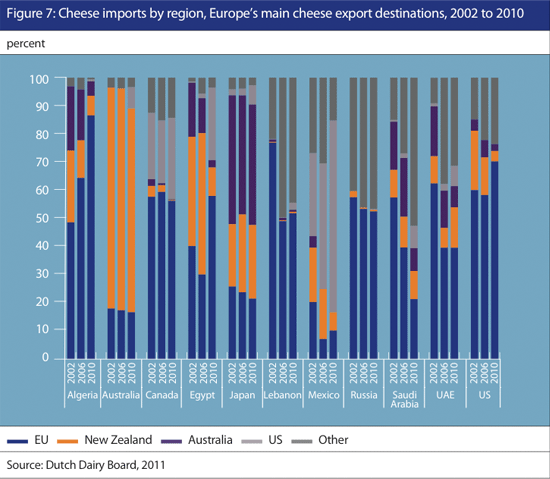
The ingredients market requires an even higher level of client focus. Assuming minimum taste and quality levels have been met, the main criteria for success are how the cheese is supplied and how well it is suited for the product applications it is used in.
Can cheese only be profitable inside a multi-product portfolio?
Specialisation is generally considered to be a strength that translates into high processing efficiency, more consistent quality and better client service models. In commodity cheeses, however, these factors are increasingly a given and there are few opportunities to create a competitive edge. Specialisation could even become a threat when ad-hoc multi-product suppliers use specialists’ core markets to dispose of milk surpluses triggered by global market drivers.
There is no easy way to avoid situations where single-product processors flood their own core markets in times of oversupply. However, the new volatility of the global dairy market requires companies to develop greater flexibility and versatility in terms of sales opportunities, especially in times of oversupply. Cooperation and joint ventures with complementary partners could be options to avoid extra investments and an inefficient capital base.
Conclusion
The EU cheese market is changing from a comfortable place where all players were able to find stability and steady growth to a market where the remaining growth will only be captured by players that have more to offer than just volume and price. EU cheese specialists need to reconsider their business models and try to incorporate new growth areas, either in new geographies or in value- adding services.
Customers in retail, foodservice and food processing are only willing to guarantee continued business or to pay premiums to suppliers that offer unique services in logistics, cutting and packing or product applications. Value-adding services will be a way for suppliers to mitigate the risks of increasing volatility in the commodity cheese market and the pressure coming from other products generating similar returns to cheese.
For the large commodity cheese manufacturers, the paramount strategic question remains whether to focus on the upstream part of the cheese value chain and continue to improve the efficiency of the cheese-making process or to find ways to develop their involvement with the downstream part of the chain by creating unique selling points or tailored customer services. Their choice will determine whether the downstream part of the chain remains populated by independent smaller specialists or whether they will become consolidated into larger integrated businesses.
The new reality in the global market dictates a balanced approach to any additional milk produced in the EU in the years to come. Extra capacity in cheese can only be justified if it is in line with EU market growth or when access to new export markets is created. Growth opportunities in markets outside the EU are interesting, but a dedicated country-by-country marketing effort will be required to provide a stronger competitive edge against exports from more efficient milk production regions.


